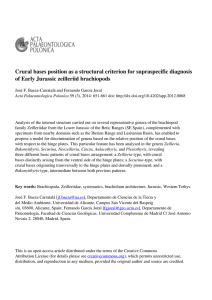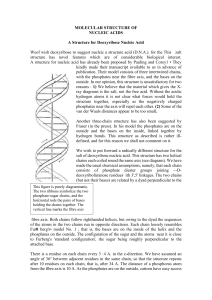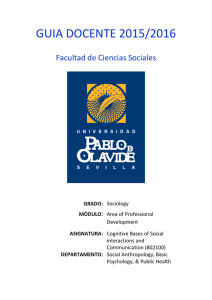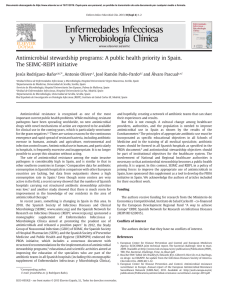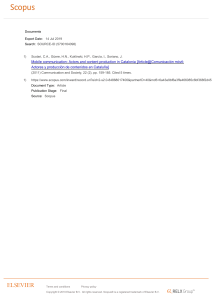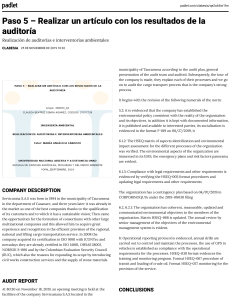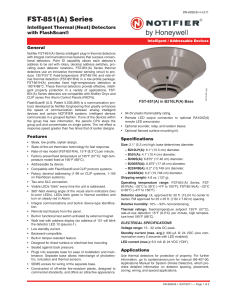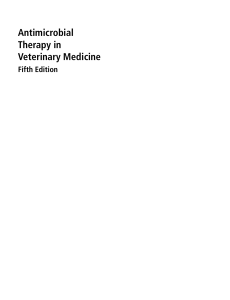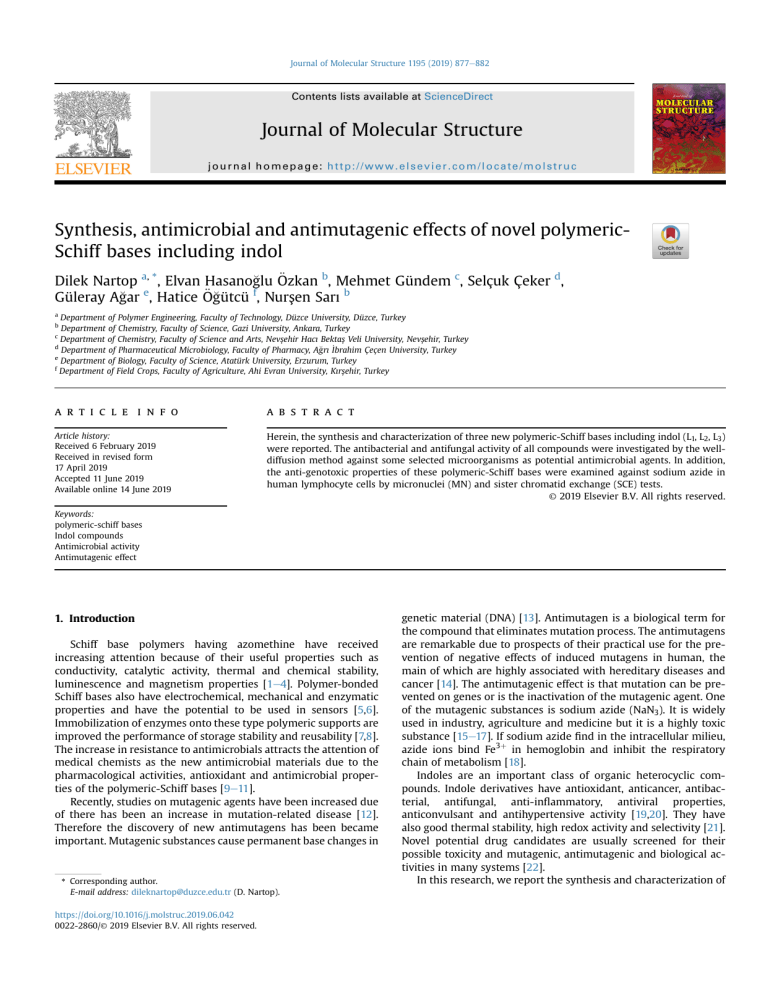
Journal of Molecular Structure 1195 (2019) 877e882 Contents lists available at ScienceDirect Journal of Molecular Structure journal homepage: http://www.elsevier.com/locate/molstruc Synthesis, antimicrobial and antimutagenic effects of novel polymericSchiff bases including indol b € lu Ozkan Dilek Nartop a, *, Elvan Hasanog , Mehmet Gündem c, Selçuk Çeker d, €g ütcü f, Nurşen Sarı b ar e, Hatice O Güleray Ag a Department of Polymer Engineering, Faculty of Technology, Düzce University, Düzce, Turkey Department of Chemistry, Faculty of Science, Gazi University, Ankara, Turkey Department of Chemistry, Faculty of Science and Arts, Nevşehir Hacı Bektaş Veli University, Nevşehir, Turkey d _ rı Ibrahim Department of Pharmaceutical Microbiology, Faculty of Pharmacy, Ag Çeçen University, Turkey e Department of Biology, Faculty of Science, Atatürk University, Erzurum, Turkey f Department of Field Crops, Faculty of Agriculture, Ahi Evran University, Kırşehir, Turkey b c a r t i c l e i n f o a b s t r a c t Article history: Received 6 February 2019 Received in revised form 17 April 2019 Accepted 11 June 2019 Available online 14 June 2019 Herein, the synthesis and characterization of three new polymeric-Schiff bases including indol (L1, L2, L3) were reported. The antibacterial and antifungal activity of all compounds were investigated by the welldiffusion method against some selected microorganisms as potential antimicrobial agents. In addition, the anti-genotoxic properties of these polymeric-Schiff bases were examined against sodium azide in human lymphocyte cells by micronuclei (MN) and sister chromatid exchange (SCE) tests. © 2019 Elsevier B.V. All rights reserved. Keywords: polymeric-schiff bases Indol compounds Antimicrobial activity Antimutagenic effect 1. Introduction Schiff base polymers having azomethine have received increasing attention because of their useful properties such as conductivity, catalytic activity, thermal and chemical stability, luminescence and magnetism properties [1e4]. Polymer-bonded Schiff bases also have electrochemical, mechanical and enzymatic properties and have the potential to be used in sensors [5,6]. Immobilization of enzymes onto these type polymeric supports are improved the performance of storage stability and reusability [7,8]. The increase in resistance to antimicrobials attracts the attention of medical chemists as the new antimicrobial materials due to the pharmacological activities, antioxidant and antimicrobial properties of the polymeric-Schiff bases [9e11]. Recently, studies on mutagenic agents have been increased due of there has been an increase in mutation-related disease [12]. Therefore the discovery of new antimutagens has been became important. Mutagenic substances cause permanent base changes in * Corresponding author. E-mail address: [email protected] (D. Nartop). https://doi.org/10.1016/j.molstruc.2019.06.042 0022-2860/© 2019 Elsevier B.V. All rights reserved. genetic material (DNA) [13]. Antimutagen is a biological term for the compound that eliminates mutation process. The antimutagens are remarkable due to prospects of their practical use for the prevention of negative effects of induced mutagens in human, the main of which are highly associated with hereditary diseases and cancer [14]. The antimutagenic effect is that mutation can be prevented on genes or is the inactivation of the mutagenic agent. One of the mutagenic substances is sodium azide (NaN3). It is widely used in industry, agriculture and medicine but it is a highly toxic substance [15e17]. If sodium azide find in the intracellular milieu, azide ions bind Fe3þ in hemoglobin and inhibit the respiratory chain of metabolism [18]. Indoles are an important class of organic heterocyclic compounds. Indole derivatives have antioxidant, anticancer, antibacterial, antifungal, anti-inflammatory, antiviral properties, anticonvulsant and antihypertensive activity [19,20]. They have also good thermal stability, high redox activity and selectivity [21]. Novel potential drug candidates are usually screened for their possible toxicity and mutagenic, antimutagenic and biological activities in many systems [22]. In this research, we report the synthesis and characterization of 878 D. Nartop et al. / Journal of Molecular Structure 1195 (2019) 877e882 three novel polymeric Schiff bases containing indol. We also investigate the antimicrobial activities and inhibitory effects of all compounds against some pathogenic bacteria and yeast. To determine the antimutagenic effect, human peripheral lymphocytes were co-treated with sodium azide, a known mutagen, and polymeric-Schiff bases, and the resulting frequencies of SCEs and MNs were calculated. 2. Experimental 2.1. Materials and physical measurements All chemicals were purchased from Sigma-Aldrich or Merck and used without further purification. Elemental analyses were performed using a Leco CHNS-932 analyser. Infrared spectra were recorded on a PerkinElmer 100 FT-IR spectrometer at 4000400 cm1 by KBr method. GPC measurements were obtained on a Tosoh EcoSEC HLC-8320 gel permeation chromatography. TGA measurements were made in PerkinElmer thermal analyser between 10 C and 910 C (in N2; rate, 10 C/min). 2.2. General procedure for synthesis of polymeric-Schiff bases including indol (L1, L2, L3) The polymeric-Schiff base L1 (or L2 or L3) was prepared by reacting of (aminomethyl) polystyrene (1 g, 4,0 mmol/g -NH2 loaded, 1% cross-linked) in hot dimethylformamide (DMF) (20 mL) and indole-3-carboxaldehyde (or 2-methylindole-3carboxaldehyde or 2-phenylindole-3-carboxaldehyde) in DMF (15 mL), as shown in Fig. 1. Aldehyde solution was added to amine solution dropwise while stirring through 30 min. After 4 h of refluxing at 70 C, the mixture was cooled to the room temperature and purification by acetone. The mixture was cooled to the room temperature and poured into acetone. The resulting clear colour solid was filtered, dried and kept in a desiccator over anhydrous CaCl2. 2.3. Detection of antimicrobial and antifungal activity The antibacterial and antifungal activities of the polymericSchiff bases including indol (L1, L2, L3) were studied by the well- diffusion method against Bacillus cereus sp., Staphylococcus aureus (ATCC 25923), Staphylococcus epidermis (ATCC 12228), Micrococcus luteus (ATCC 93419), Listeria monocytogenes 4b (ATCC 19115), Salmonella typhi H (NCTC 901.8394), Brucella abortus (RSKK-03026), Escherichia coli (ATCC 1230), Klebsiella pneumonia (ATCC 27853), Proteus vulgaris (RSKK 96026) and Candida albicans (Y-1200-NIH). In this screening, DMF was used as solvent control. It was found to have no antimicrobial activity against any of the tested organisms. All polymeric-Schiff bases were kept dry at room temperature and dissolved (3.5 mg/mL) in DMF. 1% (v/v) of a 24-h broth culture containing 106 CFU/mL was placed in sterile Petri dishes. Molten nutrient agar was studied for culturing the test bacteria and it was kept at ca. 45 C. The molten agar was added into sterile petri dishes and was allowed to solidify. Then, holes of 6 mm diameter were punched carefully using a sterile cork borer and the test solutions were completely filled into each of the bores. As the last stage, the bacteria were incubated at 37 C for 24 h. The mean value obtained for all the holes were used to calculate the zone of growth inhibition of samples. Bacterial cultures and yeast were tested for resistance to five antibiotics (produced by Oxoid Ltd., Basingstoke, UK): ampicillin (preventing the growth of gram-negative bacteria), nystatin (binding to sterols in the fungal cellular membrane, altering the permeability, and allowing leakage of the cellular contents), kanamycin (sensitive gram () and gram (þ) are indicated for the treatment of infections that are sensitive to microorganisms), sulphamethoxazole (a bacteriostatic antibacterial agent that interferes with folic acid synthesis in susceptible bacteria), amoxicillin (it is a penicillin effective against gram (þ) and gram () microorganisms and it is a broad spectrum antibiotic with bactericidal effect). 2.4. Detection of antimutagenic activity The anti-genotoxic properties of the polymeric-Schiff bases including indol (L1, L2, L3) were studied against sodium azide (NaN3) in human lymphocyte cells by sister chromatid exchanges (SCE) and micronucleus (MN) assays. Peripheral blood lymphocytes were taken from four (two men and two women) non-smoking healthy individuals. Lymphocyte cultures were set up by adding 0.5 mL of heparinized whole blood to RPMI-1640 chromosome medium supplemented with 15% heat Fig. 1. Synthesis of polymeric-Schiff bases (L1, L2, L3). D. Nartop et al. / Journal of Molecular Structure 1195 (2019) 877e882 879 Table 1 Infrared vibrations, thermal data and physical properties of polymeric-Schiff bases (L1, L2, L3). Compound Chemical formula Colour, Maw L1 L2 L3 (Mw, Mn), PDI n(CH)arom. n(CH)aliph. n(C]N) n(C]C)arom. Ti (oC) T1/2 (oC) Tf (oC) Residue mass at 900 C (wt%) [(C8H8)10(C18H16N)] Yellow, 1286 (1385, 1087), 1.27 3043 [(C8H8)10(C19H18N2) Yellow, 1314 (1329, 1201), 1.11 3014 [(C8H8)6(C24H20N2)] Yellow, 960 (970, 811), 1.20 3028 2909 2915 2929 1651 1614 1657 1585 1571 1586 268,12 450,13 281,72 435,95 271,85 453,46 871,43 15,25 838,48 18,73 901,26 22,53 *Determined by elemental analyses. then resuspended in 1 mL of fresh fixative, dropped onto a clean microscope slide, incubated at 37 C or at room temperature overnight, and stained with Giemsa dye. Encoded slides were scored blind by two independent individuals. Only binucleated cells were scored for MN analysis. For each subject, at least 1000 binucleated cells were analyzed for the presence of MN [24]. For the MN scoring, the micronucleus criteria described by Countryman and Heddle were used: a diameter less than 1/3 of the main nucleus, non-refractility, not touching, and with the same colour as the nucleus or lighter [25]. inactivated fetal calf serum, 100 IU/mL streptomycin, 100 IU/mL penicillin and 1% L-glutamine. Lymphocytes were stimulated to divide by 1% phytohaemagglutinin. The well-known mutagen NaN3 (5 mM) was used as positive control. The experiments were performed on eight groups for each compound as follows: Group 1:Solvent control; Group 2: 5 mM NaN3; Group 3: Compound 80 mg/mL; Group 4: 5 mM NaN3 þ Compound (5 mg/mL); Group 5: 5 mM NaN3 þ Compound (10 mg/mL); Group 6: 5 mM NaN3 þ Compound (20 mg/mL); Group 7: 5 mM NaN3 þ Compound (40 mg/mL); Group 8: 5 mM NaN3 þ Compound (80 mg/mL); For SCE demonstration, the cultures were incubated at 37 C for 72 h, and 5-bromo 2-deoxyuridine at 8 mg/mL was added at the initiation of cultures. All cultures were kept in dark, and then, 0.1 mg/mL of colcemide was added 3 h before harvesting to arrest the cells at metaphase. The cultures were centrifuged at 1200 g for 10 min. The supernatants were used for enzyme analysis. Cells were harvested and treated for 28 min with hypotonic solution (0.075 M KCl) and fixed in a 1:3 mixture of acetic acid/methanol (v/v). Bromodeoxyuridine incorporated metaphase chromosomes were stained with fluorescence plus Giemsa technique as described previously [23]. In SCE study, by selecting 60 satisfactory metaphases, the results of SCE were recorded on the evaluation table. For each treatment condition, well-spread second division metaphases containing 42e46 chromosomes in each cell were scored, and the values obtained were calculated as SCEs per cell. For MN analysis, the cultures were incubated at 37 C for 72 h then Cytochalasin B was added 44 h after phytohaemagglutinin (PHA) stimulation to a final concentration of 3 g/mL. Twenty-eight hours later (after 72-h cultivation), the cells were harvested by centrifugation (1200r x 10 min). The supernatant was removed. The cells were harvested and treated for 20 min at 37 C with hypotonic solution (0.05 M KCl), centrifuged for 10 min at 1200 r/min, and then fixed in a 1:3 mixture of glacial acetic acid/methanol (v/v). This fixative process was repeated three times. The cell pellet was 3. Results and discussion 3.1. Characterization of polymeric-Schiff bases including indol (L1, L2, L3) The analytical data and some of physical properties of polymeric-Schiff bases including indol (L1, L2, L3) are presented in Table 1. The weight average moleculer weight (Mw), the number average moleculer weight (Mn) and polydispersity index (PDI) were determined with gel permeation chromatography (GPC). Additionally, (Mw) was suggested from elemental analysis. The elemental analyzes can be considered compatible with the chemical formulas of the compounds. The characteristic IR spectra of polymeric-Schiff bases including indol are presented in Table 1. Imine bands were observed in the region 1614-1657 cm1. This observation indicate that the condensation of amine and carbonyl groups [26]. The nC ¼ C bands of all polymeric-Schiff bases are observed in the ranges 15711586 cm1 [27]. The n(CH)aromatic and n(CH)aliphatic bands were observed in the region 3014e3043 and 2909-2929 cm1, respectively. Thermal analysis results of polymeric-Schiff bases including indol presented in Table 1 and in Fig. 2. The TGA curve of L1 exhibited one-step weight. The values of initial (Ti) and finally (Tf) decomposition temperature were 268,12 and 871,43 C, respectively. L2 exhibited one-step weight and the values of Ti and Tf were 281,72 and 838,48 C, respectively. The TGA curve of L3 also consists Table 2 Antimicrobial activities of polymeric-Schiff bases (L1, L2, L3) (diameter of zone of inhibition (mm)). Microorganisms B.cereus sp. S.aureus S.epidermis sp. M..luteus L.monocytogenes 4b S.typhi H Br. abortus E.coli K.pneumoniae P.vulgaris C. albicans (Fungus) DMF (solvent control) Compounds Positive Control L1 L2 L3 K30 SXT25 AMP10 AMC30 NYS100 25 15 20 e 20 20 e 23 e 20 30 e 19 18 18 e 27 19 e 25 e 25 26 e 25 22 23 e 23 22 e 18 e 22 30 e e 25 e e e 20 e 25 e e e e e 24 e e e 17 e 18 e e e e e 30 e e e 11 e 10 e e e e e 30 e e e 19 e 14 e e e e e e e e e e e e e e 20 e K30 Kanamycin 30 mg, SXT25 Sulfamethoxazol 25 mg, AMP10 Ampicillin 10 mg, AMC30 Amoxycillin 30 mg, NYS100 Nystatin 100 mg, (–; (positive control) not tried). 880 D. Nartop et al. / Journal of Molecular Structure 1195 (2019) 877e882 to the high decomposition temperature values, it can be concluded that all compounds are thermally stable. The TGA curve of (L1, L2, L3) exhibited residue mass of 15,25%, 18,73% and 22,53% at 900 C, respectively. In the disintegration of the polymeric-Schiff bases, these values corresponded to the percent of residual solid in polymer matrix at final temperature. The molecular weights (Mw, Mn) and the molecular weight distribution (Mw/Mn) are given in Table 1. According to the gel permeation chromatography, polymeric-Schiff bases have a very narrow molecular weight distribution (PDI: 1.27, 1.11 and 1.20 for L1, L2 and L3, respectively). 3.2. Antimicrobial activity The antifungal and antimicrobial activities for polymeric-Schiff bases including indol (L1, L2, L3) are presented in Table 2. The polymeric-Schiff bases were screened for antimicrobial activity against gram positive Bacillus cereus sp., Staphylococcus aureus, Staphylococcus epidermis, Micrococcus luteus, Listeria monocytogenes 4b, gram negative Salmonella typhi H, Brucella abortus, Escherichia coli, Klebsiella pneumonia, Proteus vulgaris and the fungus Candida albicans in DMF solvent control. All polymeric-Schiff bases are exhibited varying degree of inhibitory effects on the growth of different tested pathogenic strains. L1 and L3 are exhibited the highest antibacterial activity against Bacillus cereus sp. The bacteria is known as opportunist pathogens and is associated with food-borne illness [29]. L2 is showed the highest activity against Listeria monocytogenes 4b. The pathogen is the causative agent of listeriosis which is the leading cause of death among foodborne bacterial pathogens [30]. Additionally, the antimicrobial activity of L1, L2 and L3 was also compared with five commercial antibiotics. L3 is showed higher antibacterial activity than K30 antibiotic, which is showed the highest activity for S.typhi H. It is known as enteric fever and is responsible for causing diseases typhoid fever in humans. K30 is also showed the highest activity for E.coli. L2 is exhibited the same activity as this antibiotic. E.coli. Additionally, L1, L2 and L3 are showed higher antifungal activity than NTYS100 antibiotic. This shows that all substances are effective against yeast. C. albicans is caused some infections for people and animals for antifungal activity [31]. The antibacterial screening results indicate that the polymeric-Schiff bases including indol (L1, L2, L3) are more effective against gram positive bacteria. 3.3. Antimutagenic activity Fig. 2. TGA/DTA curves of polymeric-Schiff bases (L1) (a), (L2) (b), (L3) (c). of one decomposition step in the range of 271,85 and 901,26 C. In the decomposition process of the polymeric-Schiff bases, the mass losses under 150 C, can be evaluated as the absorbed volatile molecules and low molecular weight segments in polymer matrix [28]. Maximum mass loss of the compounds is at 900 C. According The antimutagenic activities for polymeric-Schiff bases including indol (L1, L2, L3) are presented in Table 3. The antigenotoxic effects of polymeric-Schiff bases were investigated against NaN3 in human lymphocyte cells by MN and SCE tests. NaN3 is a well-known genotoxic agents, widely affecting many organisms. The different concentrations (5, 10, 20 and 40 mg/mL) of L1, L2, L3 were studied for reduced the toxic effect of NaN3. Compared to control group with SCE and MN frequencies determined when NaN3 is added to culture media, NaN3 is determined to induce DNA damage. The SCE and MN frequencies are increased depending on NaN3 and observed values are statistically significant (p < 0.05). A comparison is made between the polymeric-Schiff bases (L1, L2, L3) and their concentrations in order to prevent NaN3 increasing the SCE and MN frequencies. According to these screening results, it was determined that the polymeric-Schiff bases have no antimutagenic properties. L3 has more effect at a concentration of mg/ mL compared to L1 and L2. The antimutagenic effects of the compounds may be related to their antioxidant action or cofactor on the enzymatic activation system [32]. D. Nartop et al. / Journal of Molecular Structure 1195 (2019) 877e882 881 Table 3 The effects of polymeric-Schiff bases (L1, L2, L3) and NaN3 on SCE and MN. Test Items Solvent control NaN3 L1 NaN3 þ L1 NaN3 þ L1 NaN3 þ L1 NaN3 þ L1 NaN3 þ L1 L2 NaN3 þ L2 NaN3 þ L2 NaN3 þ L2 NaN3 þ L2 NaN3 þ L2 L3 NaN3 þ L3 NaN3 þ L3 NaN3 þ L3 NaN3 þ L3 NaN3 þ L3 Concentrations Range of SCE SCE/Cell ± S.E. MN numbers ±S.E. 5 mM 80 mg/mL 5 mM þ 5 mg/mL 5 mM þ 10 mg/mL 5 mM þ 20 mg/mL 5 mM þ 40 mg/mL 5 mM þ 80 mg/mL 80 mg/mL 5 mM þ 5 mg/mL 5 mM þ 10 mg/mL 5 mM þ 20 mg/mL 5 mM þ 40 mg/mL 5 mM þ 80 mg/mL 80 mg/mL 5 mM þ 5 mg/mL 5 mM þ 10 mg/mL 5 mM þ 20 mg/mL 5 mM þ 40 mg/mL 5 mM þ 80 mg/mL 2e7 8e14 2e6 7e13 6e12 5e12 4e11 3e8 2e6 7e13 6e13 5e12 4e10 3e8 2e8 7e12 6e12 5e11 4e9 3e7 6.04 ± 0.2a 13.70 ± 0.22e 6.07 ± 0.18a 13.50 ± 0.12e 13.64 ± 0.17e 13.30 ± 0.53e 13.42 ± 0.81e 13.26 ± 0.44e 6.10 ± 0.18a 13.68 ± 0.17e 13.46 ± 0.66e 13.52 ± 0.76e 13.54 ± 0.33e 13.40 ± 0.35e 6.14 ± 0.11ab 13.00 ± 0.73d 12.84 ± 0.16de 12.70 ± 0.64d 12.74 ± 0.38d 12.68 ± 0.25cd 4.23 ± 0.71a 9.34 ± 0.52e 4.42 ± 0.48b 9.12 ± 0.40e 9.04 ± 0.55e 9.00 ± 0.73de 8.92 ± 0.33d 8.95 ± 0.35d 4.36 ± 0.48a 9.20 ± 0.17e 9.14 ± 0.64e 9.09 ± 0.87e 8.96 ± 0.28d 8.90 ± 0.44d 4.34 ± 0.48a 9.06 ± 0.19e 8.92 ± 0.54d 8.90 ± 0.57d 8.86 ± 0.45cd 8.94 ± 0.97d Sodium azide (NaN3) was used as positive controls for human lymphocytes. L1: [(C8H8)10(C18H16N)]; L2: [(C8H8)10(C19H18N2)]; L3: [(C8H8)6(C24H20N2)]. a, b, c, d, e, f Statistically significant differences in the same column are indicated by the different superscripts (a ¼ 0.05). 4. Conclusions In this work, novel polymeric-Schiff base including indol were synthesized by condensation method and were structurally identified using spectral analyses. The inhibitory activities of the polymeric-Schiff bases were investigated against the mutagenic effects of NaN3. The protective roles of the compounds are related to their concentration. The antimicrobial activities of the compounds were also evaluated for antimicrobial activity against some pathogenic strains. All compounds were exhibited varying degree of inhibitory effects on the growth of different tested pathogenic strains. According to the antimicrobial results, it can be said that the polymeric-Schiff base including indol are pharmacologically active compounds and may be used in various biomedical applications as antimicrobial agents. [7] [8] [9] [10] [11] [12] [13] Acknowledgements We thank Düzce University and Nevşehir Hacı Bektaş Veli University for equipment funding. [14] [15] Appendix A. Supplementary data [16] Supplementary data to this article can be found online at https://doi.org/10.1016/j.molstruc.2019.06.042. [17] References [18] [1] L.Y. Jin, M.M. Li, D.B. Dang, Y. Bai, Y.N. Zheng, A Silver(I) coordination polymer based on a Schiff base ligand: synthesis, crystal structure and luminescence properties, Z. Naturforsch. 68b (2013) 284e288. [2] R. Rasool, S. Hasnain, N. Nishat, Metal-based Schiff base polymers: preparation, spectral, thermal and their in vitro biological investigation, Des. Monomers Polym. 17 (2013) 217e226. [3] H. Mighani, E. Fathollahi, M. Ghaemy, Synthesis and characterization of novel polyester containing Schiff-base unit, Polimeros 25 (2015) 447e450. [4] V.B. Valodkar, G.L. Tembe, M. Ravindranathan, H.S. Rama, Catalytic oxidation of alkanes and alkenes by polymer-anchored amino acid-ruthenium complexes, J. Mol. Catal. A Chem. 223 (2004) 31e38. [5] Y.L. Kobzar, I.M. Tkachenko, V.N. Bliznyuk, O.V. Shekera, T.M. Turiv, P.V. Soroka, V.G. Nazarenko, V.V. Shevchenko, Synthesis and characterization of fluorinated poly(azomethine ether)s from new corefluorinated azomethine-containing monomers, Des, Monomers Polym 19 (2016) 1e11. [6] L. Ravikumar, S. Kalaivani, T. Vidhyadevi, A. Murugasen, S.D. Kirupha, [19] [20] [21] [22] [23] S. Sivanesan, Synthesis, characterization and metal ion adsorption studies on novel aromatic poly(azomethine amide)s containing thiourea groups, Open J. Polym. Chem. 4 (2014) 1e11. S. Kayhan, N. Sarı, D. Nartop, Nanoplatforms attached Schiff bases by condensation method; Investigation of glucose oxidase enzyme as biocatalysts, Artif. Cells. Nanomed. Biotechnol. 43 (2015) 224e229. E. Aynacı, N. Sarı, H. Tümtürk, Immobilization of b-galactosidase on novel polymers having Schiff bases, Artif. Cells blood Substit. Biotechnol. 39 (2011) 259e266. S.A., Khan, S.A.A. Nami, A. Kareem, N. Nishat, Synthesis, characterization and antimicrobial study of polymeric transition metal complexes of Mn(II), Co(II), Ni(II), Cu(II) and Zn(II), Microb. Pathog. 110 (2017) 414e425. Y. Sindhu, C.J. Athira, M.S. Sujamol, R.S. Joseyphus, K. Mohanan, Synthesis, characterization, DNA cleavage, and antimicrobial studies of some transition metal complexes with a novel Schiff base derived from 2-aminopyrimidine, Synth. React. Inorg. Metal-Org. Nano-Metal Chem. 43 (2012) 226e236. L. Wang, Y. Feng, J. Xue, Y. Li, Synthesis and characterization of novel porphyrin Schiff bases, J. Serb. Chem. Soc. 73 (2008) 1e6. L.I. Vorobjeva, S.K. Abilev, Antimutagenic properties of bacteria: Review, Appl. Biochem. Microbiol. 38 (2002) 97e107. K. Sloczynska, K. Panczyk, A.M. Waszkielewicz, H. Marona, E. Pe˛ kala, In vitromutagenic, antimutagenic, and antioxidant activities evaluation and biotransformation of some bioactive 4-substituted 1-(2-methoxyphenyl) piperazine derivatives, J. Biochem. Mol. Toxicol. 30 (2016) 593e601. € Hatice, A. Güleray, S. Nurşen, Schiff bases attached L_ Ş. Iffet, A. Mustafa, O. Glutamine and L-Asparagine: first investigation on antimutagenic and antimicrobial analysis, Artif. Cells Nanomed. Biotechnol 42 (2014) 199e204. D. Slamenova, A. Gabelova, The effects of sodium azide on mammalian cells cultivated in vitro, Mutat. Res.-Fund. Mol. M. 71 (1980) 253e261. H. Shan, Y. Chu, P. Chang, L. Yang, Y. Wang, S. Zhu, M. Zhang, L. Tao, Neuroprotective effects of hydrogen sulfide on sodium azide-induced autophagic cell death in PC12 cells, Mol. Med. Rep. 16 (2017) 5938e5946. J.P.M. Wood, T. Mammone, G. Chidlow, T. Greenwell, R.J. Casson, Mitochondrial inhibition in rat retinal cell cultures as a model of metabolic compromise: mechanisms of injury and neuroprotection, IOVS (Investig. Ophthalmol. Vis. Sci.) 53 (2012) 4897e4909. T. Ishikawa, B.L. Zhu, H. Maeda, Effect of sodium azide on the metabolic activity of cultured fetal cells, Toxicol. Ind. Health 22 (2006) 337e341. A.F. Ghaidan, F.L. Faraj, Z.S. Abdulghany, Synthesis, characterization and cytotoxic activity of new indole Schiff bases, derived from 2-(5-chloro-3,3dimethyl-1,3-dihydro-indol-2-ylidene)-malonaldehyde with substituted aniline, Orient, J. Chem. 34 (2018) 169e181. P. Kamaria, N. Kawathekar, P. Chaturvedi, Microwave assisted synthesis and antimicrobial evaluation of Schiff bases of indole-3-aldehyde, E-Journal of Chemistry 8 (2011) 305e311. lu, E. Hasdemir, A.O. Solak, Z. Üstündag , R. Güzel, Preparation and D. Deletiog characterization of poly(indole-3-carboxaldehyde) film at the glassy carbon surface, Thin Solid Films 519 (2010) 784e789. A.H. Warda, A.I. Mohamed, M.A. Abdullah, M.E. Wael, Evaluation of the biological activity of novel monocationic fluoroaryl-2,20 -bichalcophenes and their analogues, Drug Des. Dev. Ther. 8 (2014) 963e972. P. Perry, H.J. Evans, Cytological detection of mutagen-carcinogen exposure by 882 D. Nartop et al. / Journal of Molecular Structure 1195 (2019) 877e882 sister chromatid Exchange, Nature 258 (1975) 121e125. [24] M. Anar, F. Orhan, L. Alpsoy, M. Gulluce, A. Aslan, G. Agar, The antioxidant and antigenotoxic potential of methanol extract of Cladonia foliacea (Huds.), Willd. Toxicol. Ind. Health. 32 (2016) 721e729. [25] P.I. Countryman, J.A. Heddle, The production of micronuclei from chromosome aberrations in irradiated cultures of human lymphocytes, Mutat. Res. 41 (1976) 321e332. [26] M.M. Abo-Aly, A.M. Salem, M.A. Sayed, A.A. Abdel Aziz, Spectroscopic and structural studies of the Schiff base 3-methoxy-N-salicylidene-o-amino phenol complexes with some transition metal ions and their antibacterial, antifungal activities, Spectrochim. Acta, Part A 136 (2015) 993e1000. [27] D. Nartop, W. Clegg, R.W. Harrington, R.A. Henderson, C.Y. Wills, Binding multidentate ligands to Ni2þ: kinetic identification of preferential binding sites, Dalton Trans. 43 (2014) 3372e3382. €g ütcü, Synthesis, characterization, and [28] D. Nartop, N. Sarı, A. Altundaş, H. O antimicrobial properties of new polystrene-bound Schiff bases and their some complexes, J. Appl. Polym. Sci. 125 (2012) 1796e1803. D. [29] J.M. Miller, J.G. Hair, M. Hebert, L. Hebert, F.J. Roberts Jr., R.S. Weyant, Fulminating bacteremia and pneumonia due to Bacillus cereus, J. Clin. Microbiol. 35 (1997) 504e507. [30] V. Ramaswamy, V.M. Cresence, J.S. Rejitha, M.U. Lekshmi, K.S. Dharsana, S.P. Prasad, H.M. Vijila, Microb. Infect. 40 (2007) 4e13. [31] M. Gloria, R. Diez-Orejas, F. Navarro-Garcia, L. Monteoliva, C. Gill, M. SanchezPerez, C. Nombela, Candida albicans: genetics, dimorphism and pathogenicity, Internatl. Microbiol. 1 (1998) 95e106. € _ Şakıyan, D. Nartop, N. Sarı, G. Ag ar, Anti-genotoxic [32] E.H. Ozkan, H.E. Kızıl, I. effects of Schiff bases and their Mn(III) complexes containing L-Aspartic acid and L-Phenylalanine, Gazi Univ. J. Sci. 31 (2018) 408e414.
